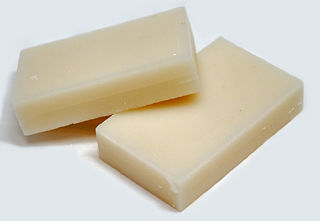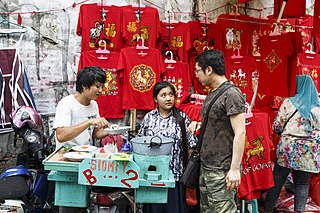
Mochi is a Japanese rice cake made of mochigome (もち米), a short-grain japonica glutinous rice, and sometimes other ingredients such as water, sugar, and cornstarch. The steamed rice is pounded into paste and molded into the desired shape. In Japan, it is traditionally made in a ceremony called mochitsuki. While eaten year-round, mochi is a traditional food for the Japanese New Year, and is commonly sold and eaten during that time.

Glutinous rice is a type of rice grown mainly in Southeast East Asia, the northeastern regions of India and Bhutan which has opaque grains, very low amylose content, and is especially sticky when cooked. It is widely consumed across Asia.

Malaysian cuisine consists of cooking traditions and practices found in Malaysia, and reflects the multi-ethnic makeup of its population. The vast majority of Malaysia's population can roughly be divided among three major ethnic groups: Malays, Chinese and Indians. The remainder consists of the indigenous peoples of Sabah and Sarawak in East Malaysia, the Orang Asli of Peninsular Malaysia, the Peranakan and Eurasian creole communities, as well as a significant number of foreign workers and expatriates.

Malaysian Chinese cuisine is derived from the culinary traditions of Chinese Malaysian immigrants and their descendants, who have adapted or modified their culinary traditions under the influence of Malaysian culture as well as immigration patterns of Chinese to Malaysia. Because the vast majority of Chinese Malaysians are descendants of immigrants from southern China, Malaysian Chinese cuisine is predominantly based on an eclectic repertoire of dishes with roots from Fujian, Cantonese, Hakka and Teochew cuisines.

Penang cuisine is the cuisine of the multicultural society of Penang, Malaysia. Most of these cuisine are sold at road-side stalls, known as "hawker food" and colloquially as "muckan carts". Local Penangites typically find these hawker fares cheaper and easier to eat out at due to the ubiquitousness of the hawker stalls and that they are open for much of the day and night. Penang island. On February 22, 2013, Penang was ranked by CNN Travel as one of the top ten street food cities in Asia. Penang has also been voted by Lonely Planet as the top culinary destination in 2014.

Chinese Indonesian cuisine is characterized by the mixture of Chinese with local Indonesian style. Chinese Indonesians, mostly descendant of Han ethnic Hokkien and Hakka speakers, brought their legacy of Chinese cuisine, and modified some of the dishes with the addition of Indonesian ingredients, such as kecap manis, palm sugar, peanut sauce, chili, santan and local spices to form a hybrid Chinese-Indonesian cuisine. Some of the dishes and cakes share the same style as in Malaysia and Singapore, known as Nyonya cuisine by the Peranakan.

A rice cake may be any kind of food item made from rice that has been shaped, condensed, or otherwise combined into a single object. A wide variety of rice cakes exist in many different cultures in which rice is eaten. Common variations include cakes made with rice flour, those made from ground rice, and those made from whole grains of rice compressed together or combined with some other binding substance.

Jiandui or sesame balls are a type of fried Chinese pastry made from glutinous rice flour. The pastry is coated with sesame seeds on the outside and is crisp and chewy after immediately being cooked. Inside the pastry is a large hollow, caused by the expansion of the dough. The hollow of the pastry is filled with a filling usually consisting of lotus paste, or alternatively, sweet black bean paste, or red bean paste.

In Vietnamese, the term bánh translates loosely as "cake" or "bread", but refers to a wide variety of prepared foods that can easily be eaten by hands or chopsticks. With the addition of qualifying adjectives, bánh refers to a wide variety of sweet or savory, distinct cakes, buns, pastries, sandwiches, and other food items, which may be cooked by steaming, baking, frying, deep-frying, or boiling. Foods made from wheat flour or rice flour are generally called bánh, but the term may also refer to certain varieties of noodle and fish cake dishes, such as bánh canh and bánh hỏi.

Chè is any traditional Vietnamese sweet beverage, dessert soup or stew, or pudding. Chè includes a wide variety of distinct soups or puddings. Varieties of Chè can be made with mung beans, black-eyed peas, kidney beans, tapioca, jelly, fruit, and coconut cream. Other types are made with ingredients such as salt, aloe vera, seaweed, lotus seed, sesame seed, sugar palm seeds, taro, cassava and pandan leaf extract. Some varieties, such as chè trôi nước, may also include dumplings. Chè are often prepared with one of a number of varieties of beans, tubers, and/or glutinous rice, cooked in water and sweetened with sugar. In southern Vietnam, chè are often garnished with coconut creme.

Javanese cuisine is the cuisine of Javanese people, a major ethnic group in Indonesia, more precisely the province of Central Java, Yogyakarta and East Java.

Yuanxiao are dumplings of glutinous rice flour, filled with sesame or peanut powder and sugar, or sweet red bean paste, eaten in a soup during the Lantern Festival, the fifteenth day of the Chinese New Year. They are similar to tangyuan, but are traditionally prepared in a basket, and served mainly in Northern China.

Betawi cuisine is rich, diverse and eclectic, in part because the Betawi people that create them were composed from numbers of regional immigrants that came from various places in the Indonesian archipelago, as well as Chinese, Indian, Arab, and European traders, visitors and immigrants that were attracted to the port city of Batavia since centuries ago.

Bua loi or bua loy is a Thai dessert. It consists of rice flour rolled into small balls, and cooked in coconut milk and sugar. Some Bua loi also adds sweet egg into the recipe. It was inspired by Tangyuan, a Chinese dessert that is traditionally eaten around the Lantern festival. Bua Loi is also traditionally eaten during the Dongzhi Festival in Thailand, which is a festival for the Chinese-Thai bloodline. There are a variety of versions of Bua loi such as ones that use food coloring instead of natural color, use soy milk instead of Coconut cream, add sliced pumpkin inside the rice balls, et cetera. There are other types of Bua loi from other countries such as China, Japan, Indonesia, Myanmar, Philippines, Southern Vietnam and Malaysia. 1 cup of Bua Loy has total calories of 295.5 kilocalories, protein of 10.4 grams, carbohydrate of 6.3 grams, and fat of 25 grams.

Dumpling is a broad class of dishes that consist of pieces of cooked dough, often wrapped around a filling. The dough can be based on bread, wheat or other flours, or potatoes, and it may be filled with meat, fish, tofu, cheese, vegetables, or a combination. Dumplings may be prepared using a variety of cooking methods and are found in many world cuisines.

Red bean paste or red bean jam, also called adzuki bean paste or anko, is a paste made of red beans, used in East Asian cuisine. The paste is prepared by boiling the beans, then mashing or grinding them. At this stage, the paste can be sweetened or left as it is. The color of the paste is usually dark red, which comes from the husk of the beans. In Korean cuisine, the adzuki beans can also be husked prior to cooking, resulting in a white paste. It is also possible to remove the husk by sieving after cooking, but before sweetening, resulting in a red paste that is smoother and more homogeneous.

Tong but lut is a Cantonese dessert. Glutinous rice flour balls in sugar syrup are sprinkled with crushed roasted peanuts. The stickiness of the balls prevents the topping from coming off, hence the name.

In the Burmese language, the term mont translates to "snack", and refers to a wide variety of prepared foods, ranging from sweet desserts to savory food items that may be cooked by steaming, baking, frying, deep-frying, or boiling. Foods made from wheat or rice flour are generally called mont, but the term may also refer to certain varieties of noodle dishes, such as mohinga. Burmese mont are typically eaten with tea during breakfast or afternoon tea time.


![Red bean Tangyuan [(Xin Bei Mei Shi )] Gu Zao Wei Wang Lai Bing Dian [(Tai Bei . Yuan Shan Zhan Lan )] Hello KittyJia Nian Hua (31630727772).jpg](http://upload.wikimedia.org/wikipedia/commons/thumb/1/1a/%E3%80%90%E6%96%B0%E5%8C%97%E7%BE%8E%E9%A3%9F%E3%80%91%E5%8F%A4%E6%97%A9%E5%91%B3%E6%97%BA%E4%BE%86%E5%86%B0%E5%BA%97_%E3%80%90%E5%8F%B0%E5%8C%97%E3%80%82%E5%9C%93%E5%B1%B1%E5%B1%95%E8%A6%BD%E3%80%91Hello_Kitty%E5%98%89%E5%B9%B4%E8%8F%AF_%2831630727772%29.jpg/220px-%E3%80%90%E6%96%B0%E5%8C%97%E7%BE%8E%E9%A3%9F%E3%80%91%E5%8F%A4%E6%97%A9%E5%91%B3%E6%97%BA%E4%BE%86%E5%86%B0%E5%BA%97_%E3%80%90%E5%8F%B0%E5%8C%97%E3%80%82%E5%9C%93%E5%B1%B1%E5%B1%95%E8%A6%BD%E3%80%91Hello_Kitty%E5%98%89%E5%B9%B4%E8%8F%AF_%2831630727772%29.jpg)























